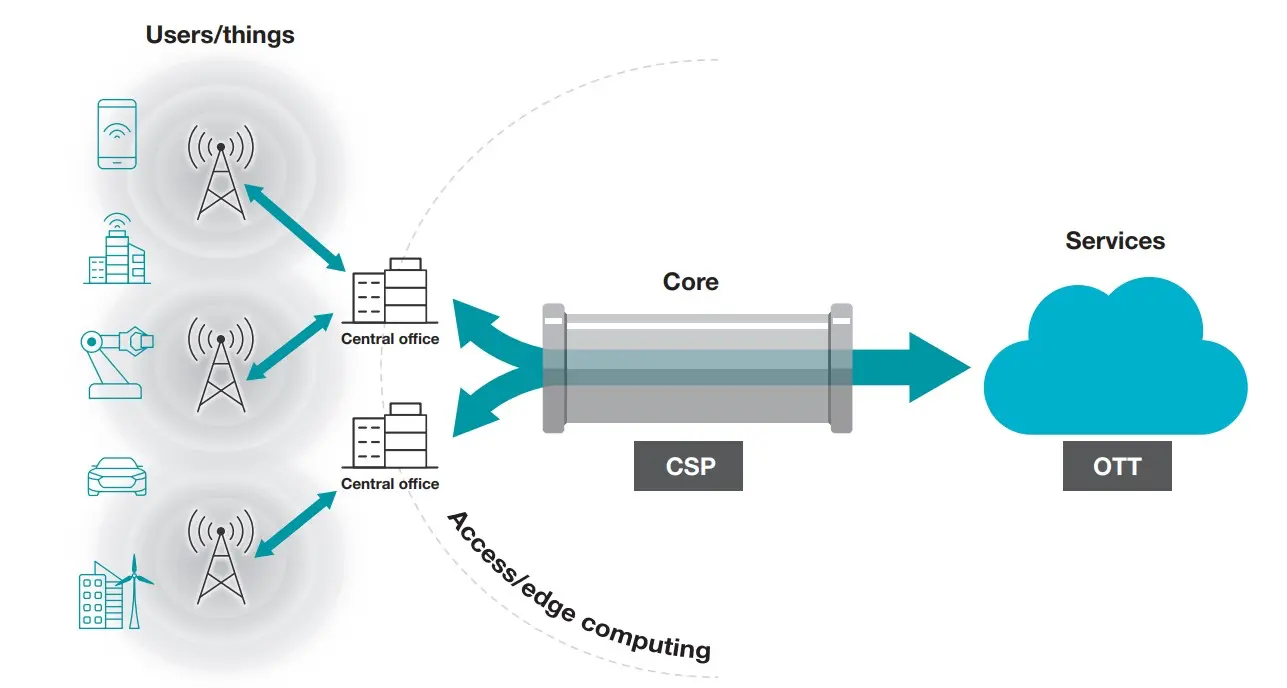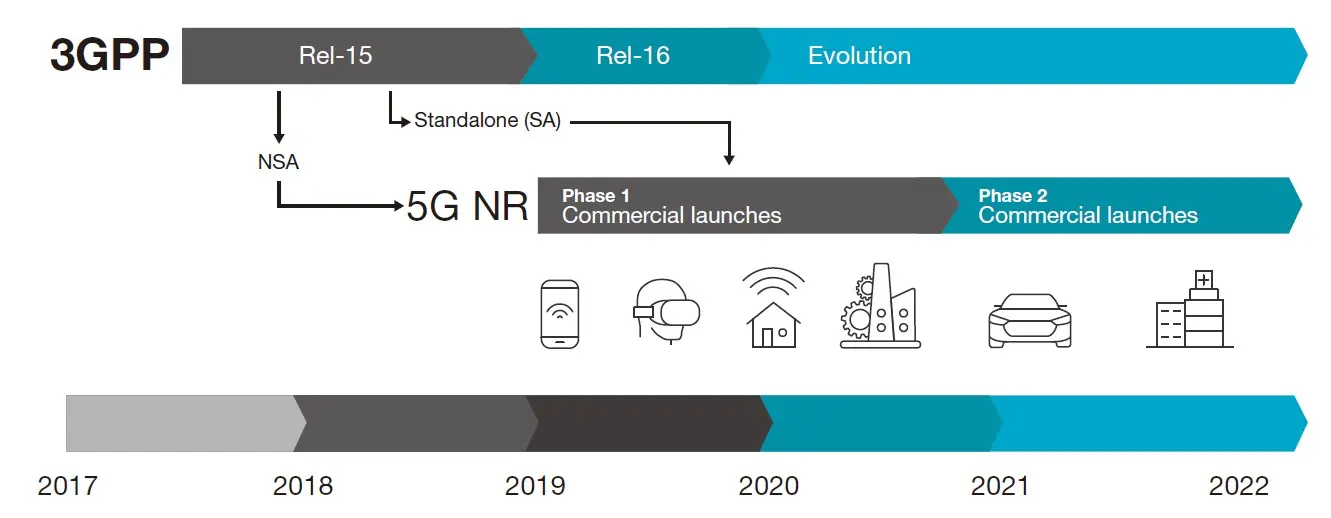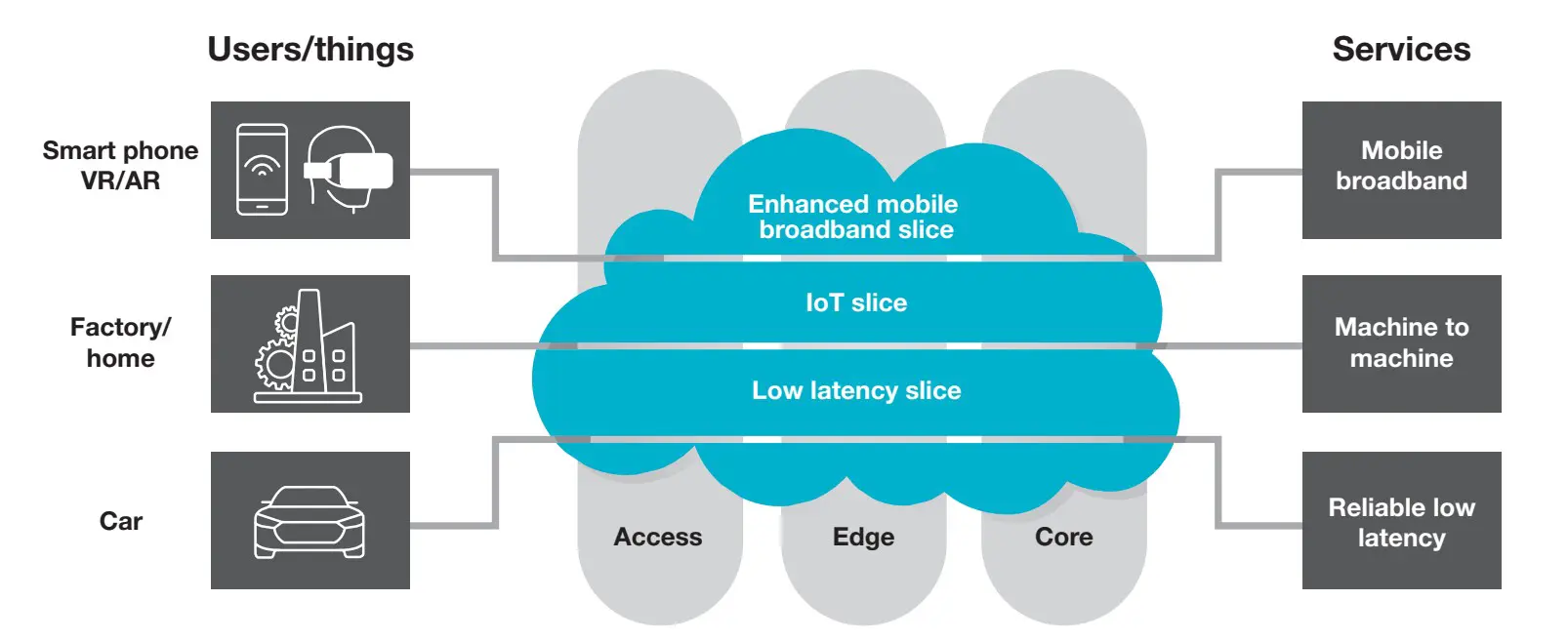随着《工业互联网创新发展行动计划》(2021~2023)的发布,标志着未来3年将是中国工业互联网快速成长期的关键期。
5G Station
5G deployment is growing strongly worldwide, which is expected to achieve ultra-low latency, faster speed, lower power consumption and more links. For users, the key of 4G is the network capacity, and the development prospect of 5G is unlimited.
5G is the backbone of the communication industry, and will achieve revolutionary applications in other markets such as industry, automobile, medical, and even national defense. For a world increasingly connected with the Internet of Things (IoT), 5G’s remarkable improvements in speed (at least 10 times faster than 4G, up to 10Gbps), latency (10 times lower than 4G, down to 1ms) and density (supporting 1 million IoT devices per square kilometer) will make many innovative applications possible, especially in important areas such as security, reliability, service quality, efficiency and cost.
As shown in the figure below, 5G will realize the interconnection of goods and services, while “goods” will reside in the user or enterprise space, while “services” will usually reside in the cloud. The 5G network will be able to flexibly split the parallel connection, perfectly adapt the service level required by users through adjustment, and provide an excellent cost/performance balance scheme.

5G is not only another “era” in the development of communication standards, but also a general term containing at least three major trends. According to the definition of the International Telecommunication Union, the first trend is enhanced mobile broadband (emBB), which will strengthen innovation areas, such as augmented reality and virtual reality. The second trend is Massive Machine Class Communication (mMTC), including ubiquitous IoT sensor connectivity. The third is ultra-high reliable low delay communication for key applications, such as automatic driving or remote surgery.
5G will be everywhere, covering smart phones, cars, utilities, wearables, hospital operating rooms, large factories, power grids and other applications, and closer to the concept of smart cities, intelligent manufacturing and the connected world.
Phased launch
The 5G new radio (NR) is linked to LTE Advanced, which is still an essential part of the 5G platform to ensure operation on the existing core network infrastructure. With the launch of the 15th version of the Third Generation Partnership Program (3GPP) completed at the end of 2017, this approach has enabled the industry to make steady progress in the spectrum below 6GHz. By 2020, the 15th edition will be able to promote the early deployment of most 5Gs.
However, it is expected that the 16th standard released in the second half of 2019 will affect the frequency spectrum above 6GH (z millimeter wave) (see the figure below).

The 16th edition is critical for critical communications services, virtual reality, and the Low Power Wide Area (LPWA) Internet of Things. This standard is expected to realize the real potential that is usually touted as the 5G vision – it will enable many applications and various new functions, such as spectrum sharing, the Cellular Internet of Vehicles (C-V2X) standard for the automotive industry, etc., thus completely changing the pattern of the communications industry.
5G business case
The first business case of 5G is very straightforward:
It improves network capacity, speed, reliability and availability, and reduces latency at the same cost as 4G.
The second business case has been put into commercial operation in the United States, that is, fixed wireless application, which uses millimeter wave frequency (3GPP has not been specified) to cover remote users, so as to provide 300Mbps or more connection as a cheap installation alternative of optical fiber. This has met the requirements of most mobile operators in the world who participated in early 5G testing and testing, as well as those operators who have built infrastructure to support the launch of 5G services (first build infrastructure in the core network, and increase the coverage density of new heterogeneous cellular networks).
Among the countries/regions that participated in early testing and testing, the United States began to promote 5G faster than any other country to prepare for the required densification of cellular network coverage, but lagged behind in the installation of base transceiver stations (BTS). As a reference, the United States installed about 200000 base stations in 2018, while China maintained about 2 million base stations. In addition, China also has 70% of the existing Internet of Things connections in the world, which makes the promotion needs of the two countries very different. As of the time of writing, there have been new frequency auctions in South Korea, Australia, the United Kingdom, Italy, Spain, the United States and Germany or they have been included in the plan.
At the 2018 World Mobile Communication Conference, GSMA predicted that by 2023, there will be about 400 million 5G connections (30% of which are in the United States) covering consumer applications and enterprise applications.
Not only communication service providers (CSPs) are full of expectations for the development of 5G, because many non-traditional players are also eager to try in the 5G field. Over the top (OTT) media providers (including Facebook, Microsoft, Google and Amazon) are closely watching the business opportunities. These OTT providers own the cloud, where most services reside, so they are the main participants in 5G operations. However, they do not have access rights, and this part is still fully hosted by CSP.
Even during the implementation of 4G, many network functions have been virtualized, which enables the public cloud part of infrastructure (infrastructure as a service) to develop significantly. However, the channel is still firmly in the hands of the CSP. The symbiotic function system requires the correct connection between providers and users and intelligent management of them. In the development process of these connections, new technologies such as network slicing and edge computing will be included, which are important new features of 5G.
Network Slice
Making computing closer to users (edge computing) is an important part of the 5G blueprint. However, another equally important future element of 5G is the concept of network slicing, which can make 4G’s software defined network concept reach a new level.
As shown in the figure below, network slicing allows operators to separate the packet flow layer from the control layer, and supports parallel running of multiple applications and services for a series of users with different quality, delay, and bandwidth levels.

This means that the 5G system will have many logical network slices (or “fast tracking channels”) to support specific applications and customers. For example, some customers of operators may need emBB to use augmented reality tools, while other customers may need networks suitable for mMTC, automatic driving or remote surgery, so they need to provide different network attributes. Each application has its own specific requirements. By dividing the network into different private sessions or parallel connections, different slices can be optimized accordingly.
This enables operators to sell networks to customers in the form of “network as a service”, so that each customer can experience the network slice, as if it is completely physically isolated from the whole: some are similar to the “willing to share a piece of cake” method, and real-time modulation of the ingredients available in the formula. In essence, network slicing can improve operational efficiency and shorten time to market to implement new services.
In fact, network slicing may be one of the biggest contributors to delivering cost-effective new 5G services to enterprise customers.
Edge computing
Edge computing means making real-time decisions close to the data source. By locating computing intelligence close to separate and different data sources, edge computing can reduce latency in the implementation of requested services. Edge computing does not send data to the cloud for processing through the entire core network, but uses a distributed network architecture to ensure near real-time processing and reduce latency at the same time. Otherwise, it is simply unacceptable for specific services.
With the proliferation of critical applications requiring real-time computing resources, and the proliferation of intelligent functions assisted by artificial intelligence (AI) such as automatic driving, telemedicine and virtual reality applications, computing is closer to the end user, and thus closer to the edge, which is crucial. For example, if the system delays for tens of milliseconds when the car traverses the entire network and returns, the car will still drive several feet more even after receiving the brake command. Using edge resources and reducing the delay by 10 times will greatly reduce the time from command to braking.
Edge computing resources (or multi access edge computing) can easily find a room in the traditional central office of the wireless access network (RAN). Additional hardware resources and servers with AI accelerators can be located within a variable distance of several kilometers from the antenna cluster. This will generate a lot of additional hardware infrastructure.
The 5G network has NR access standards and features, so it is suitable for multiple vertical markets with different applications. This has resulted in excessive hardware requirements, including the requirements for active antenna system (AAS) and other equipment, which has also evolved the concept of remote radio head end through integrated antennas. This integration helps solve the challenges 5G faces in the following aspects: using spatial diversity and local beams to improve capacity, and implementing large-scale MIMO (mMIMO) technology.
AAS, mMIMO and beamforming
The AAS technology can maximize the efficiency of the base station, and facilitate operators to significantly increase their capacity (up to five times of 5G) and network coverage. The power amplifier (PA) cluster and antenna elements are the basic components of AAS (up to 1024 PAs can be included at present), which can provide a complete network access function to connect to the baseband node, where the baseband node can be located in the same location as the AAS or in the central office (cloud RAN). Frequency multiplexing can be realized through mMIMO (this technology is based on spatial diversity and supports multiple synchronization and separate data paths for individual users), and frequency multiplexing has become the main factor to improve BTS capacity, which is used to implement spatial multiplexing.
When multiple antennas are used, enhanced beamforming technology can also be used, which uses 3D directional and focused beams. This technology reduces the interference in adjacent channels, maximizes the reachable distance with equal power, and directs the data flow to the desired target. Therefore, it can optimize the overall capacity and achieve higher radio signal throughput.
AAS was deployed in the final stage of 4G. Now, as a new device, AAS is widely used where capacity and coverage need to be improved. The implementation of new spectrum supporting backward compatible 4G hardware and baseband supporting upgradable software will also promote the hardware upgrade of macro BTS.
In order to increase the coverage density of new services, especially in dense environments such as high-rise apartment buildings, stadiums, shopping centers and theme parks, small cells will need to be deployed to make transmission closer to users with lower power consumption and higher bit rate.
From the perspective of hardware, the most prominent challenge is density, mainly including: first, how to achieve comprehensive thermal management in smaller and smaller packages. Second, how to effectively meet expectations through large-scale integration of functions and components. Third, while achieving all this, maintain high performance with low power consumption.
To achieve this, all components in AAS, from transceivers to clocks to power management, must be redesigned or adjusted to meet the challenging requirements generated by the increasing number of components in the new device. This can be realized from the radio frequency (RF) transceiver, integrating more RF transceivers, adding auxiliary functions and creating intelligent system solutions to cluster many new components through common power management.
Timing, integrated transceiver and power consumption
Highly integrated multi-channel RF transceiver is the core element of 5G hardware blueprint. This not only requires RF signal bandwidth up to 1GHz, but also supports multi band operation. By implementing RF sampling technology, the described characteristics can be implemented in a simpler architecture at a lower cost. The serializer/deserializer transceiver has a performance higher than 10Gbps and an integrated low jitter phase-locked loop (PLL)/voltage controlled oscillator (VCXO). As another key function of these emerging on-chip systems, they can simplify the generation of sampling clocks by allowing the use of reference clocks with lower frequencies.
Meeting the timing requirements of 5G high bandwidth networks cannot be ignored. In the current mobile network, the timing source (voltage controlled crystal oscillator (VCXO)/temperature compensated crystal oscillator (TCXO)) must have very low jitter and be able to meet the requirements of continuously reducing noise to support higher-order quadrature amplitude modulation and obtain the best millimeter wave transmission performance.
According to the cloud RAN architecture, the latest Common Radio Interface (CPRI) specification (named eCPRI (EthernetCPRI)), as a multi-point link between the baseband unit (BBU) pool and the remote radio unit (RRU) network, provides a high bandwidth link to handle the requirements of multiple RRU. Since 5GeCPRI is used in 5G forward transmission, new timing requirements need to be met. In the point-to-point CPRI link, time synchronization and frequency synchronization must be guaranteed in essence, but this kind of synchronization is no longer an afterthought problem, but needs to be solved as a part of the entire 5G timing solution. Therefore, the clock tree has evolved from VCXO based jitter remover solution adopted by CPRI transmission to TCXO based network synchronizer solution to handle the timing requirements in eCPRI.
In addition, the 5G macro base station will also support the multicarrier global mobile communication system standard (GSM) for transmissions below 6GHz. Therefore, the clock tree must also meet the point phase noise requirements that do not violate the overall GSM blocker specification. For a 5GmMIMO base station, the use of beamforming technology can effectively utilize the spectrum while minimizing interference. This affects the skew between various outputs in the clock tree of the RF signal link
Tight constraints are formed. In addition to the system level antenna calibration plan, there are a variety of board level and chip level technologies (for example, zero delay mode) that can minimize the delay changes of the clock tree in the process, voltage and temperature angles to improve beam forming efficiency.
5G is also changing the load point paradigm to meet a series of power consumption requirements of the Internet of Things, small cellular networks and active antennas. The power swing (expansion) range is from a few tenths of a watt to hundreds of watts. More specifically, with the increase of power consumption/current requirements, the value of distribution bus has been changed to 12V to meet the requirements of AAS, distributed antenna system and new generation mMIMO radio.
With the increase of power consumption in RRU and BBU, the role of power management bus (PMBus) is more and more obvious. At the same time, high-voltage step-down converters are constantly improving to adapt to the increase in the number of PAs, requiring 3D thermal dissipation and 100V operating converters with variable current limits. In order to provide precise clock and transceiver circuits in the radio while increasing the density, the size and noise can also be reduced through multi-channel dedicated converters. The converter is used as a substitute for the low dropout voltage regulator, and the switching speed is higher than 1MHz, so as to reduce the size while maintaining the efficiency.
Minimizing the content, complexity and cost of bill of materials is the key to win the 5G hardware competition, and integrating functions into integrated circuits is the way to achieve these goals. Semiconductor companies will have to work closely with their base station equipment customers to produce highly integrated RF transceivers, optimized signal chains and power supplies to support the continuous development of 5G technology.
The recent historical data of the communication industry shows that the cycle of upgrading to the next generation technology is 10 years. The speed adopted by 5G is similar to it, followed by the expectation of its peak maturity.
5G is ready to inject new vitality into the concept of connected earth through new infrastructure, new equipment and new use cases. With its high capacity and low latency, 5G will completely change the contact between people and equipment.
From the enterprise level, 5G may be more transformative and can achieve mission critical services that are expected to completely change the entire industry. In the real 5G era, machine to machine technology, low-power sensors, mobility management, remote equipment/asset monitoring and smart grid will be all over the future factories.
Other aspects of 5G will be enhanced when higher spectrum is enabled in the 16th edition. Millimeter wave mesh network can be used to realize low-cost small cellular base station backhaul transmission in densely populated urban areas. These networks will also be applicable to workshop or vehicle connected everything communication system, thus making this technology a key driving force for automatic driving, because vehicles need to communicate with vehicles, traffic signals and the latest digital map information.
5G may be a future oriented network, but it embodies the hard work of current engineers and will certainly make the world we live in a better place.

